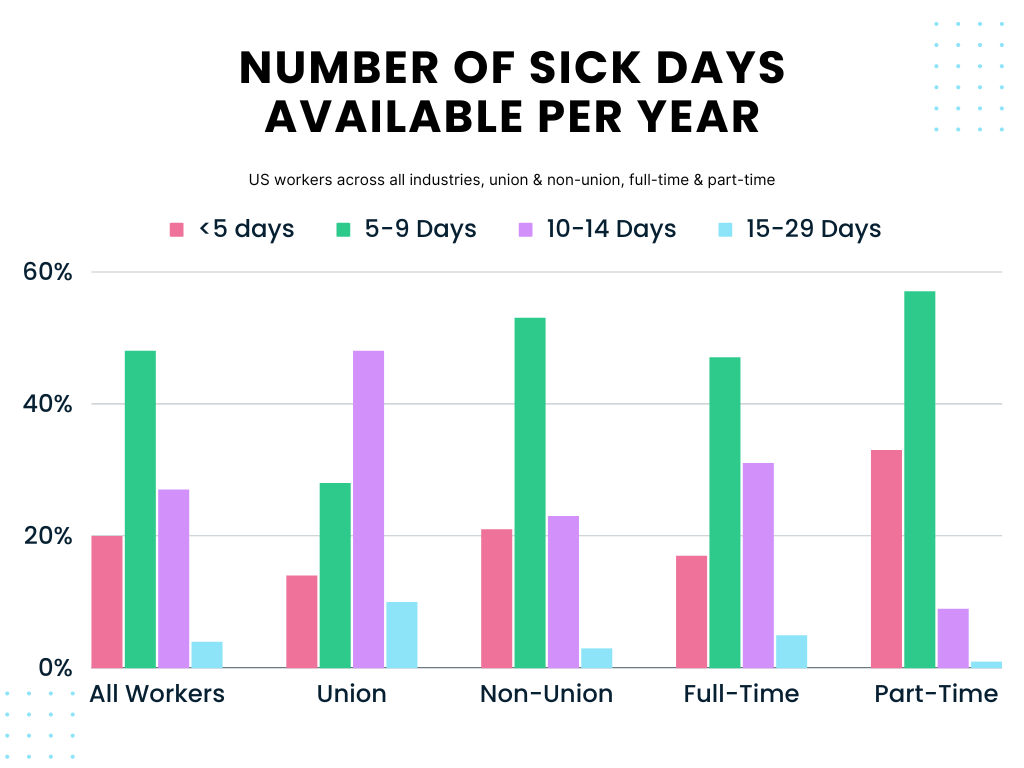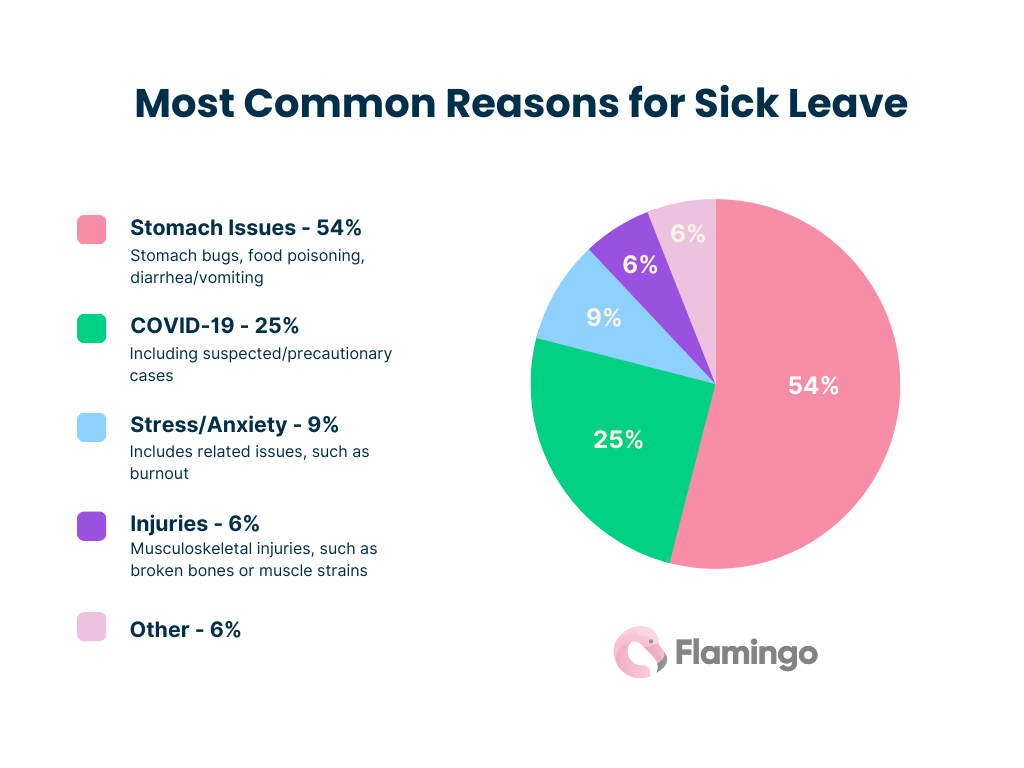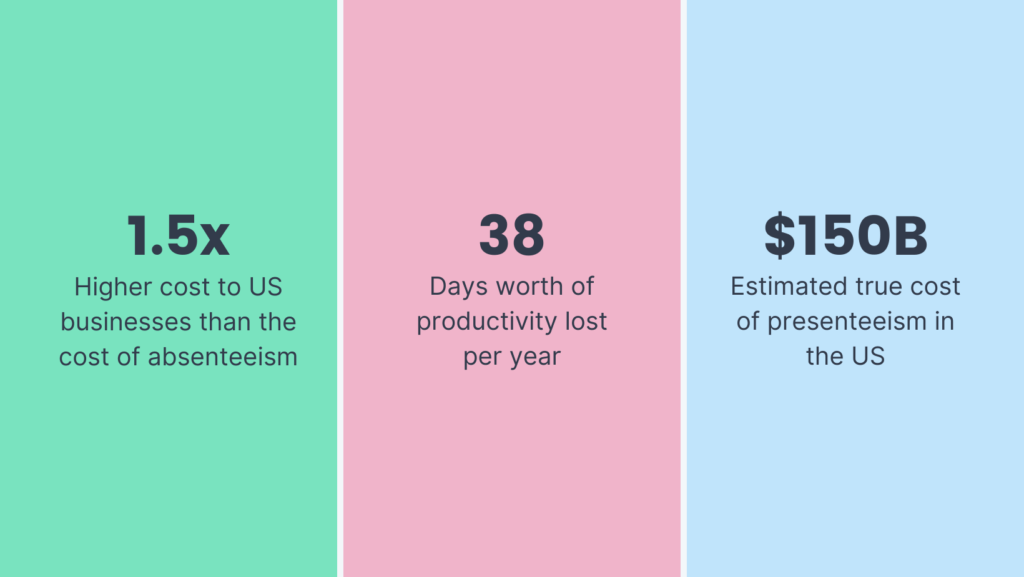November 18, 2024
Presenteeism: The $150 Billion Problem for Modern Businesses
What if your organization is losing more productive hours from employees showing up than from those staying h...
Sick days are a normal thing. Most businesses today offer paid sick leave. But if you’re wondering how many sick days a year is a normal amount, or how many sick days people take on average, you’re in the right place.
Keep reading and we’ll share the latest sick leave data from US businesses and employees. We’ll also break down the key takeaways from the data, along with tips on how you should manage paid sick leave in your business.
Trending Article: These 15 major companies offer unlimited PTO. Should your company do the same?
The average US business provides between 6-10 paid sick days per year.
Data from the US Bureau of Labor Statistics shows the average number of sick days for several different groups (for those who receive a fixed number of paid sick days).

In terms of distribution, 48% of all workers with paid sick leave receive between 5-9 days per year. 27% receive 10-14 days per year, while 20% receive less than 5 days of sick leave per year.
The distribution is similar for most groups; 53% of non-union workers, 47% of full-time employees and 57% of part-time employees receive between 5-9 sick days per year.
However, it differs only for union workers, with 48% receiving between 10-14 sick days per year, with 28% receiving between 5-9 sick days per year.

Paid sick leave is not a federal requirement in the United States. The US is one of the few countries in the world that does not have paid sick leave as a legal requirement.
Some states, however, do have laws governing paid sick leave, while some states have local laws in certain regions relating to paid sick leave. These states are:
Despite the fact that many are not legally obliged, 79% of US workers receive paid sick leave. Some other sources have this number even higher. A Farah & Farah survey of 1012 workers found that 90% of respondents had access to paid sick leave, while a SHRM survey (3,129 participants) found that 96% had paid sick leave.
Now, when we’re discussing how many sick days per year is normal, sick leave allowance is just one side of the question. We also need to look at how many sick days on average people actually take, which can be much different to the number of days on offer.
Though there are no federal laws regarding paid sick leave, some laws do cover unpaid sick leave.
The Family and Medical Leave Act (FMLA), for example, requires businesses to provide up to 12 weeks of unpaid, job-protected leave for serious health conditions (as well as for caring for family members with serious health conditions).
But there is a big difference between unpaid and paid sick time. Sick employees need the security of knowing that they won’t be hurting financially when they get sick.
That’s why companies need to provide paid sick days, not just allow employees to take time off on their own dime.
According to a Statista survey, 47% of Americans took 3 or fewer paid sick days in the last 12 months.
This figure was at 50% at the end of 2021 and 58% at the end of 2020.
Another source, a survey from Censuswide and LinkedIn, found similar results, with working professionals taking an average of 2.5 days sick leave per year.
These numbers are likely lower than expected, showing that sick leave abuse is far from the norm.
And there’s one more, somewhat alarming takeaway from the Statista survey quoted above.

In the most recent data, 26% of Americans took zero sick days in the last 12 months.
This survey has tracked data at regular intervals since 2020. In late 2020 and early 2021, the number of Americans who hadn’t taken a sick day in the past year was as high as 34%.
These numbers become even more significant when you consider that 25% of survey respondents did not work or go to school, or did not answer. So, realistically, the fraction of working Americans who go 12 months or longer without taking a sick day is closer to the 35-45% region.
Americans have 6 to 10 days of sick leave available on average, but only take an average of 2-3 days per year.
Some, particularly employers or managers, will see this as a good thing. Fewer absences means higher productivity, lower expenses, right?
Yet most people are unwell for more than just a few days a year. The CDC says most adults catch a common cold 2 or 3 times a year, for which symptoms can last 7 to 10 days. That’s not even taking into account other viruses, infections, injuries, and stomach illnesses, which according to some sources are the cause of over 50% of sick days.

More likely, the large number of unused sick days are due to employees being pressured against taking sick time. Sick days are often seen as a negative, and employees who don’t take sick leave are praised as the hardest workers.
Yet employees not taking sick leave when they’re unwell or unfit to work costs businesses more than the cost of sick leave. This is a condition called “presenteeism”, which is estimated to cost US companies in excess of $150 billion per year in lost productivity and associated costs.

If you’re a US-based business, there may not be a lot of legal guidance in terms of how much sick leave you should offer.
You may not need to offer any paid sick leave at all. While in some states, the legal requirement may be very small.
But this doesn’t mean you should offer the minimum. Consider the wellbeing of your staff, along with the fact that you’re competing with other companies for the best talent in the job market.
With this in mind, offering at least the higher end of the US average (10 days per year) is a good idea. Though if you want to take a more progressive stance, offer higher than average – or even unlimited paid sick days per year.
Cases of sick leave abuse are far more rare than you would think. Instead of limiting your sick leave due to fear of abuse, raise (or remove) your limit, and deal with the few cases of abuse when (and if) they happen.
This will have a big impact on job satisfaction, retention and hiring power for your business, and may even boost productivity by allowing employees to be at 100% more often.
We’re very comfortable with saying that most employees need to take more sick leave.
The average number of sick days taken by US employees is much below what is available, and even the average number of sick days available is significantly below the worldwide averages (the UK, for example, allows up to 28 weeks of paid sick leave per year).
Either Americans are just healthier than the rest of the world, or the negative culture around sick leave causes most in the US to come to work when they’re sick far too often.
There are three reasons why employees may not take enough sick leave.
The first is that there is not enough sick leave available. If a company doesn’t offer paid sick leave, or the amount is very low, they should think about increasing it.
Even if employees don’t use all their sick leave, it could still be due to a low overall limit. For example, if an employee only has 5 days per year of paid sick leave, they may choose against taking a sick day for a minor illness, as they feel like they need to keep their sick days in case something more major comes up.
The second reason is pressure from their employer. A lot of managers or leaders discourage their employees from taking sick leave. They may even go as far as disciplining employees who call in sick.
The third, and most common reason, is pressure that employees put on themselves.
Though their company may not actively discourage employees from taking sick leave, the employee believes that it will hurt their standing and reputation if they’re seen to be taking too many sick days.
As an employer or a leader, you should want your employees to take sick leave when they’re sick.
This means your employees will be more productive and more engaged when they are at work, as they’ll get the time to rest and recover when they get sick. Additionally, it reduces the risk of chronic illnesses, spreading illness to other employees, and workplace accidents caused by employees coming to work when unfit.
Here are some tips to help make sure your employees take a sick day when they need it.
It’s not necessarily a bad thing if someone doesn’t take much sick leave. It could simply be that they have had a good run of not getting sick.
But if you have low sickness rates across the board in your business, there might be a problem. Consider what the cause may be, and make a plan to address it.
You should make it easy for your team members to ask for a sick day, and set up a clear process to track and manage sick days.
If you’re using Slack, Flamingo is a great way to do this. It offers a smooth and stress-free process to request paid sick days, while tracking and recording absences in case you need to follow up.
You can put a limit on how much paid sick leave team members can take each year, or simply check the reports to identify trends requiring action.
This is the best way to ensure a sick employee has the freedom to take time off and recover, while protecting against loss of productivity due to absenteeism.
Flamingo streamlines leave management, letting you spend less time managing paid time off and more time growing your business
Sick leave should be more normalized than it is today. Even people with healthy lifestyles can’t avoid getting sick every once in a while.
Yet, while most US businesses provide paid sick leave benefits, the data shows that a lot of us never take it. That may not be an issue – perhaps these people just aren’t getting sick – but if people are getting sick and still coming to work, it becomes a problem.
Make sure your business makes it clear that paid sick time is there and available should employees need it. A day or two at home is better than working through an illness and turning it into a long-term problem.
Flamingo® makes managing your team’s paid time off a breeze.